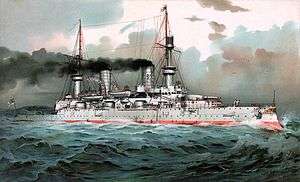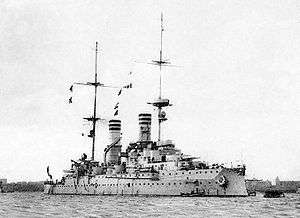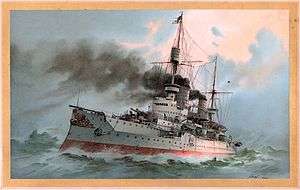Kaiser Friedrich III-class battleship
 SMS Kaiser Wilhelm II | |
| Class overview | |
|---|---|
| Builders: |
|
| Operators: |
|
| Preceded by: | Brandenburg class |
| Succeeded by: | Wittelsbach class |
| Built: | 1895–1901 |
| Completed: | 5 |
| Scrapped: | 5 |
| General characteristics | |
| Class and type: | Pre-dreadnought battleship |
| Displacement: |
|
| Length: | 125.3 m (411 ft 1 in) |
| Beam: | 20.4 m (66 ft 11 in) |
| Draft: | 7.89 m (25 ft 11 in) |
| Propulsion: | |
| Speed: | 17.5 knots (32.4 km/h; 20.1 mph) |
| Range: | 3,420 nmi (6,330 km; 3,940 mi) at 10 knots (19 km/h; 12 mph) |
| Complement: | 658–687 |
| Armament: |
|
| Armor: |
|
Kaiser Friedrich III-class battleships were a class of pre–World War I, pre-dreadnought battleships of the German Kaiserliche Marine. The class was made up of five ships, all of which were named for German emperors. The Kaiser Friedrich III class saw the introduction of the traditional armament layout for German battleships—four large-caliber guns, but of comparatively smaller caliber compared to contemporary battleships, in two gun turrets—prior to the advent of the dreadnought type of battleship in the early 1900s. They also standardized the use of three screws for battleships.[1]
Kaiser Friedrich III was laid down at Wilhelmshaven Navy Dockyard in March, 1895, followed by Kaiser Wilhelm II in October, 1896, also in Wilhelmshaven. Kaiser Wilhelm der Grosse was laid down at Germania, Kiel in January, 1898, followed by Kaiser Barbarossa at Schichau, Danzig in August of that year, and Kaiser Karl der Grosse, a month later in September, at Blohm & Voss, Hamburg. Work on all five vessels was completed by 1901.
The five Kaiser Friedrich III-class battleships were assigned to the I Squadron of the Home Fleet (Heimatflotte) after commissioning. Here they conducted extensive annual training maneuvers with the rest of the fleet. After ten years of fleet service, they were replaced with newer ships. They were transferred to the III Squadron of the fleet, which had by then been reorganized as the High Seas Fleet, and placed in reserve. The ships were recalled to active service at the outbreak of World War I, but saw limited duty during the war. They initially served in V Squadron, until 1915, when the ships were relegated to auxiliary roles, primarily as prison ships. After the war, all five of the ships were sold and scrapped by 1922.
Design
Design work on the class began in 1892 and lasted until 1894.[2] The ships of the Kaiser Friedrich III class marked a significant departure from the previous Brandenburg-class battleships. Influenced by the Japanese cruisers' victory over a heavier-armed Chinese fleet at the Battle of Yalu, heavy-caliber guns designed to penetrate armor were abandoned and replaced with smaller quick-firing guns. These guns were intended to raze the superstructure of enemy battleships and demoralize the crew.[3][4] The propulsion system was improved and reorganized to incorporate a third propeller shaft.[5] The armor system, however, remained similar to that employed on the Brandenburgs.[2]
General characteristics

The Kaiser Friedrich III-class ships were 120.9 meters (396 ft 8 in) long at the waterline and 125.3 m (411 ft 1 in) overall. They had a beam of 20.4 m (66 ft 11 in) and a draft of 7.89 m (25 ft 11 in) forward and 8.25 m (27 ft 1 in) aft. The ships displaced 11,785 metric tons (11,599 long tons) at full load. Transverse and longitudinal steel frames were used to build the hulls for the Kaiser Friedrich III-class ships. Steel hull plates were riveted to the frame. The hull contained twelve watertight compartments and a double bottom that ran for 70 percent of the hull.[6]
The German navy regarded them as excellent sea vessels. They had a tight turning circle and were very responsive. The ships rolled up to 15° and had a roll period of 12 seconds. They suffered only minor speed loss in heavy seas, but up to 40 percent with the rudder hard over. Their metacentric height was between .917 to 1.18 m (3 ft 0.1 in to 3 ft 10.5 in). The ships carried a number of smaller boats, including two picket boats, two launches, one pinnace, two cutters, two yawls, and two dinghies. The crew numbered 39 officers and 612 enlisted men. When serving as a squadron flagship, a ship had its crew augmented by another 12 officers and between 51 to 63 enlisted men.[6]
Machinery
The Kaiser Friedrich III-class battleships were powered by three 3-cylinder vertical triple expansion engines that drove three screws. Kaiser Friedrich III, Kaiser Barbarossa, and Kaiser Wilhelm der Grosse were equipped with three 3-bladed screws that were 4.5 m (14 ft 9 in) in diameter. Kaiser Karl der Grosse and Kaiser Wilhelm II were equipped with two of the 3-bladed screws on the outer shafts and a four-bladed screw that was 4.2 m (13 ft 9 in) in diameter on the center shaft. Kaiser Friedrich III had four Thornycroft and eight cylindrical boilers; Kaiser Wilhelm II had a similar arrangement, except the Thornycroft boilers were replaced by Marine-type boilers. Kaiser Wilhelm der Grosse was equipped with four Marine and six cylindrical boilers, while Kaiser Barbarossa had four Thornycroft and six cylindrical boilers. Kaiser Karl der Grosse had two Marine boilers, two Marine double boilers, and six cylindrical boilers.[6]
The powerplants were rated at 13,000 metric horsepower (12,822 ihp; 9,561 kW), but on trials could produce up to 13,950 PS (13,760 ihp; 10,260 kW). This generated a top speed of 17.5 knots (32.4 km/h; 20.1 mph). The ships carried 650 metric tons (640 long tons; 720 short tons) of coal, although the use of additional spaces within the ships increased fuel capacity to 1,070 metric tons (1,050 long tons; 1,180 short tons). This provided a maximum range of 3,420 nautical miles (6,330 km; 3,940 mi) at a cruising speed of 10 knots (19 km/h; 12 mph). Electrical power was supplied by five 320 kW 74 Volt generators in Kaiser Friedrich III and Kaiser Wilhelm II, and four 240 kW 74 V generators in the other three ships.[6]
Armament

The ships' armament consisted of a main battery of four 24 cm (9.4 in) SK L/40 guns in twin gun turrets,[lower-alpha 1] one fore and one aft of the central superstructure.[7] The guns were mounted in Drh.L. C/98 turrets, which allowed elevation to 30° and depression to −5°. At maximum elevation, the guns could hit targets out to 16,900 meters (18,500 yd). The guns fired 140-kilogram (310 lb) shells at a muzzle velocity of 690 m/s (2,263 ft/s). They had a rate of fire of three to four shots per minute. Each gun was supplied with 75 shells, for a total of 300.[8]
Secondary armament included eighteen 15 cm (5.9 inch) SK L/40 guns; six were emplaced in single turrets amidships and twelve were mounted in MPL casemates.[lower-alpha 2] These guns fired armor-piercing shells at a rate of 4–5 per minute. The ships carried 120 shells per gun, for a total of 2,160 rounds total. The guns could depress to −7 degrees and elevate to 20 degrees, for a maximum range of 13,700 m (14,990 yd). They were manually elevated and trained.[9]
The ships also carried twelve 8.8 cm (3.45 in) SK L/30 quick-firing guns,[6] also mounted in casemates. These guns were supplied with between 170 and 250 shells per gun. These guns fired 13.8 kg (30.4 lb) at a muzzle velocity of 590 m/s (1,936 ft/s). Their rate of fire was approximately 15 shells per minute; the guns could engage targets out to 10,500 m (11,480 yd). The gun mounts were manually operated.[10] The ships' gun armament was rounded out by twelve machine guns.[6]
The ships were also armed with six 45 cm torpedo tubes, all in above-water swivel mounts. Four tubes were mounted on the sides of the ship, another in the bow, and the last in the stern.[6] These weapons were 5.1 m (16 ft 9 in) long and carried an 87.5 kg (193 lb) TNT warhead. They could be set at two speeds for different ranges. At 26 knots (48 km/h; 30 mph), the torpedoes had a range of 800 m (870 yd). At an increased speed of 32 knots (59 km/h; 37 mph), the range was reduced to 500 m (550 yb).[11]
Armor
The Kaiser Friedrich III-class ships were armored with steel produced by Krupp. They had an armor belt that was 300 millimeters (12 in) thick in the central portion of the hull at the waterline. It tapered to 150 mm (5.9 in) in the forward section and 200 mm (7.9 in) in the rear, although the belt did not extend fully aft. The lower portion of the belt ranged in thickness from 100 to 180 mm (3.9 to 7.1 in). The entire belt was backed with 250 mm (9.8 in) of teak. The armored deck was 65 mm (2.6 in) thick.[6]
The conning tower was protected by armored sides that were 250 mm thick and a roof that was 30 mm (1.2 in) thick. Each main-battery turret had a 50 mm (2.0 in) thick roof and 250 mm thick sides. The 15 cm guns mounted in turrets were protected by 150 mm thick sides and 70 mm (2.8 in) thick gun shields. Those in the casemates also had 150 mm worth of armor protection.[6]
Construction

Kaiser Friedrich III, the first ship of the class, was ordered from the Kaiserliche Werft Wilhelmshaven as Ersatz Preussen.[lower-alpha 3] She was intended to replace the old armored frigate Preussen. She was laid down in 1895 under construction number 22.[6] She was launched on 1 July 1896, after which fitting out commenced; this included the installation of the ship's armament and the completion of the superstructure. The ship was completed and commissioned into the German fleet on 7 October 1898.[12] Kaiser Wilhelm II's keel was laid in Wilhelmshaven in 1896, also at the Kaiserliche Werft, under construction number 24. She was ordered under the contract name Ersatz Friedrich der Grosse, to replace the armored frigate Friedrich der Grosse.[6] Kaiser Wilhelm II was launched on 14 September 1897 and commissioned on 13 February 1900.[12]
Kaiser Wilhelm der Grosse was ordered under the contract name Ersatz König Wilhelm as a replacement for the obsolete König Wilhelm. Her keel was laid at the Germaniawerft dockyard under construction number 79 in 1898.[6] The ship was launched on 1 June 1899 and commissioned into the fleet on 5 May 1901.[12] The keel for Kaiser Barbarossa—ordered as "B", an addition to the fleet—was laid down at the Schichau-Werke in Danzig in 1898. Her construction number was 640.[6] She was launched on 21 April 1900 and commissioned into the German navy on 10 June 1901.[12] Also in 1898, Kaiser Karl der Grosse was laid down at the Blohm & Voss shipyard in Hamburg under construction number 136. She was ordered as an addition to the fleet, and so was assigned the contract name "A".[6] The last ship of the class to be completed, Kaiser Karl der Grosse was launched on 18 October 1899 and commissioned into the fleet on 4 February 1902.[12]
Ships
| Ship | Builder | Namesake | Laid down | Launched | Commissioned | Fate |
|---|---|---|---|---|---|---|
| Kaiser Friedrich III | Kaiserliche Werft, Wilhelmshaven | Kaiser Friedrich III | March 1895 | July 1896 | October 1898 | Broken up at Kiel, 1920 |
| Kaiser Wilhelm II | Kaiser Wilhelm II | October 1896 | September 1897 | February 1900 | Broken up at Bremen, 1921 | |
| Kaiser Wilhelm der Grosse | Germaniawerft, Kiel | Kaiser Wilhelm I | January 1898 | June 1899 | May 1901 | Broken up at Kiel, 1920 |
| Kaiser Karl der Grosse | Blohm & Voss, Hamburg | Emperor Charlemagne | September 1898 | October 1899 | February 1902 | Broken up at Bremen, 1920 |
| Kaiser Barbarossa | Schichau-Werke, Danzig | Emperor Frederick I | August 1898 | April 1900 | June 1901 | Broken up at Rüstringen, 1920 |
Service history

When Kaiser Wilhelm II was commissioned into the fleet, she assumed the position of fleet flagship; she held this position until 1906.[1] The other four ships joined her in the I Squadron of the Heimatflotte (Home Fleet), where they remained for ten years.[2] The five ships took part in extensive training maneuvers in September 1902 with the rest of the fleet.[13] Throughout the maneuvers the Kaiser Friedrich III-class ships operated as the opposing force, with the exception of Kaiser Wilhelm II. As the fleet flagship, Kaiser Wilhelm II hosted Wilhelm II during several of the mock engagements and served as the observation point for the senior staff.[14]
Between 1907 and 1910, the ships of the class were heavily rebuilt, with the exception of Kaiser Karl der Grosse.[6] During the modernization, the ships had their superstructures cut down. Four 15 cm guns and one torpedo tube were also removed. The ships' 8.8 cm guns were repositioned to the upper decks where the 15 cm guns had been located.[1] Also, the smoke stacks were lengthened.[7]
By 1911, the fleet was reorganized as the Hochseeflotte (High Seas Fleet), and new dreadnought battleships were beginning to enter service. As a result, the Kaiser Friedrich III-class ships were transferred to the III Squadron and then placed into reserve. In 1914, with the outbreak of World War I, the five ships were recalled to active duty and placed in the V Squadron of the fleet. In February 1915, the ships were withdrawn from active service for a second time.[2] The ships were disarmed by 1916 and transferred to secondary roles.[1] Kaiser Wilhelm der Grosse became a torpedo training ship and Kaiser Wilhelm II became the headquarters ship for the commander of the High Seas Fleet in Wilhelmshaven. The other three ships were used as floating prisons.[7] In 1917, Kaiser Friedrich III was transferred to barracks ship duties in Flensburg. All of the ships, with the exception of Kaiser Wilhelm II, were stricken from the navy register on 6 December 1919 and sold for scrapping. Kaiser Wilhelm II followed on 17 March 1921. By 1922, all five ships had been broken up for scrap metal. The bow ornaments from Kaiser Friedrich III and Kaiser Wilhelm II are preserved at the Militärhistorisches Museum der Bundeswehr in Dresden.[12]
Footnotes
Notes
- ↑ In Imperial German Navy gun nomenclature, "SK" (Schnelladekanone) denotes that the gun is quick firing, while the L/40 denotes the length of the gun. In this case, the L/40 gun is 40 caliber, meaning that the gun is 40 times as long as it is in diameter. See: Grießmer, p. 177.
- ↑ MPL stands for Mittel-Pivot-Lafette (Central pivot mounting). See NavWeaps (Ammunition).
- ↑ German warships were ordered under provisional names; new additions to the fleet were given letter designations, while those that were intended to replace older vessels were given "Ersatz (name of the ship to be replaced)".
Citations
References
| Wikimedia Commons has media related to Kaiser Friedrich III class battleship. |
- Gardiner, Robert; Gray, Randal, eds. (1985). Conway's All the World's Fighting Ships: 1906–1921. Annapolis: Naval Institute Press. ISBN 978-0-87021-907-8.
- Gardiner, Robert; Chesneau, Roger; Kolesnik, Eugene M., eds. (1979). Conway's All the World's Fighting Ships: 1860–1905. London: Conway Maritime Press. ISBN 978-0-85177-133-5.
- Grießmer, Axel (1999). Die Linienschiffe der Kaiserlichen Marine [The Battleships of the Imperial Navy] (in German). Bonn: Bernard & Graefe Verlag. ISBN 978-3-7637-5985-9.
- Gröner, Erich (1990). German Warships: 1815–1945. Annapolis: Naval Institute Press. ISBN 978-0-87021-790-6.
- Herwig, Holger (1998) [1980]. "Luxury" Fleet: The Imperial German Navy 1888–1918. Amherst: Humanity Books. ISBN 978-1-57392-286-9.
- Hore, Peter (2006). The Ironclads. London: Southwater Publishing. ISBN 978-1-84476-299-6.
- Kelly, Patrick J. (2011). Tirpitz and the Imperial German Navy. Bloomington: Indiana University Press. ISBN 978-0-253-35593-5.
- Ropp, Theodore (1987). Roberts, Stephen S., ed. The Development of a Modern Navy: French Naval Policy, 1871–1904. Annapolis: Naval Institute Press. ISBN 978-0-87021-141-6.
- "German Naval Manoeuvres". R.U.S.I. Journal. London: Royal United Services Institute for Defence Studies. 47: 90–97. 1903.
Online sources
- DiGiulian, Tony (6 April 2009). "Germany 24 cm/40 (9.4") SK L/40". NavWeaps.com. Retrieved 28 March 2010.
- DiGiulian, Tony (20 October 2008). "German 15 cm/40 (5.9") SK L/40". NavWeaps.com. Retrieved 29 March 2010.
- DiGiulian, Tony (22 March 2007). "German 8.8 cm/30 (3.46") SK L/30 8.8 cm/30 (3.46") Ubts L/30". NavWeaps.com. Retrieved 29 March 2010.
- DiGiulian, Tony (21 April 2007). "German Torpedoes Pre–World War II". NavWeaps.com. Retrieved 2 September 2009.
- DiGiulian, Tony (22 May 2012). "Germany — Ammunition, Guns and Mountings Definitions". NavWeaps.com. Retrieved 21 August 2012.